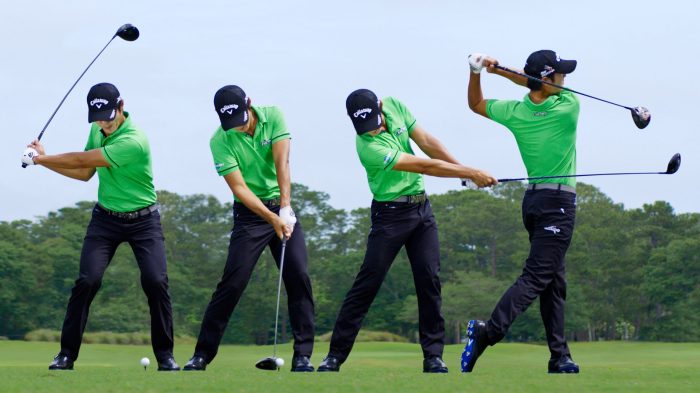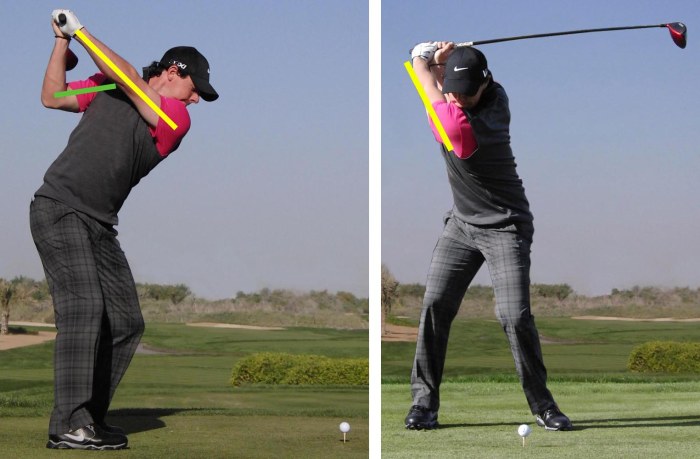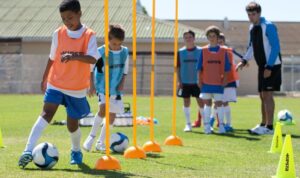Looking to up your golf game? Dive into the world of golf swing tips, where we break down the essentials in a cool and informative way that’ll have you hitting the green like a pro in no time.
From nailing the basics to fixing common mistakes and leveraging technology, we’ve got you covered with everything you need to know to improve your swing game.
Golf Swing Basics
To excel in golf, mastering the fundamental components of a golf swing is crucial. Let’s delve into the key elements that can help you improve your game.
Proper Grip, Stance, and Alignment
- Having a proper grip on the club is essential for control and power. Make sure your hands are placed comfortably on the club, with your lead hand (top hand) in a position that allows for a strong and secure grip.
- Your stance sets the foundation for a successful swing. Maintain a balanced and athletic stance, with your feet shoulder-width apart and knees slightly flexed. This will help you generate power and stability during the swing.
- Alignment plays a crucial role in ensuring that your shots go where you intend them to. Position your body parallel to the target line, with your feet, hips, and shoulders aligned correctly. This will help you hit the ball with accuracy and precision.
Generating Power and Accuracy
- Focus on a smooth and controlled backswing, ensuring that you rotate your body and shift your weight properly to create power.
- Engage your lower body in the swing by initiating the downswing with your hips and transferring your weight from back foot to front foot. This will add speed and power to your shot.
- Keep your head steady and eyes on the ball throughout the swing to maintain accuracy and contact with the ball. Avoid any unnecessary movement that can disrupt your shot.
Common Golf Swing Mistakes
When it comes to golf swing mistakes, even the most experienced players can fall into bad habits that affect their game. Identifying these common errors and knowing how to correct them can significantly improve your performance on the course.
Over-swinging
Over-swinging is a common mistake where golfers try to hit the ball too hard by taking the club too far back. This often leads to a loss of control and accuracy in the swing. To correct over-swinging, focus on maintaining a smooth and controlled backswing, ensuring that your body rotation is in sync with your arm movement. Practice shortening your backswing to find the right balance of power and control.
Poor Weight Transfer
Another frequent mistake is poor weight transfer during the swing. Failing to shift your weight properly from back foot to front foot can result in weak shots and inconsistent ball striking. To improve weight transfer, practice drills that emphasize shifting your weight smoothly from your back foot to your front foot as you swing through the ball. Focus on maintaining balance and stability throughout the swing.
Avoiding Slices and Hooks
Slices and hooks are common ball flight errors that can be frustrating for golfers. A slice occurs when the ball curves to the right (for right-handed golfers) and a hook when it curves to the left. To avoid slices, focus on your grip, ensuring that your clubface is square at impact. For hooks, work on your hand position and release to promote a straighter ball flight. Practice drills and lessons with a golf pro can help you correct these issues and improve your overall consistency on the course.
Improving Swing Technique

To become a better golfer, it’s crucial to focus on improving your swing technique. By incorporating drills, exercises, and tips, you can enhance your mechanics, develop a consistent swing, and understand the importance of tempo and rhythm in achieving success on the course.
Drills and Exercises for Better Swing Mechanics
- Practice the waggle: Before taking your swing, practice a small, rhythmic back-and-forth motion to loosen up and establish a smooth tempo.
- Swing plane drills: Use alignment sticks or a mirror to ensure your club is on the correct swing plane throughout your swing, promoting better contact and accuracy.
- Hip rotation exercises: Focus on rotating your hips properly during the swing to generate power and maintain balance, leading to more consistent shots.
Developing a Consistent and Repeatable Swing
- Focus on a relaxed grip: Holding the club too tightly can lead to tension in your swing, affecting consistency. Maintain a light grip pressure for better control.
- Create a pre-shot routine: Develop a consistent pre-shot routine that includes visualization, alignment, and breathing exercises to prepare your mind and body for each swing.
- Work on alignment and ball position: Consistent alignment and ball position are key factors in developing a repeatable swing. Practice setting up correctly for every shot.
The Role of Tempo and Rhythm in a Successful Golf Swing
- Find your natural tempo: Experiment with different swing speeds to discover the tempo that works best for you. Maintaining a consistent tempo throughout your swing can lead to improved timing and contact.
- Use a metronome: Practicing with a metronome can help you establish a steady rhythm in your swing, promoting smooth transitions and better ball striking.
- Focus on the transition: Pay attention to the transition from backswing to downswing, ensuring a smooth and controlled shift of momentum to maintain tempo and rhythm.
Using Technology for Swing Analysis: Golf Swing Tips

Technology has revolutionized the way we analyze and improve our golf swings. From launch monitors to swing analyzers, these tools provide valuable insights that can take your game to the next level.
Benefits of Video Analysis
- Video analysis allows you to visually see your swing mechanics, helping you identify areas of improvement.
- By comparing your swing to professional golfers or your previous swings, you can pinpoint specific flaws and work on correcting them.
- Video feedback provides a clear visual representation of your swing progress over time, allowing you to track improvements.
Integrating Data-Driven Feedback, Golf swing tips
- Utilize launch monitors to gather data on ball flight, clubhead speed, and other key metrics to understand the impact of your swing adjustments.
- Swing analyzers can provide real-time feedback on swing path, clubface angle, and tempo, helping you make immediate corrections on the course.
- Incorporate data-driven feedback into your practice routine by setting specific goals based on the insights gathered from technology, leading to more efficient and targeted practice sessions.
